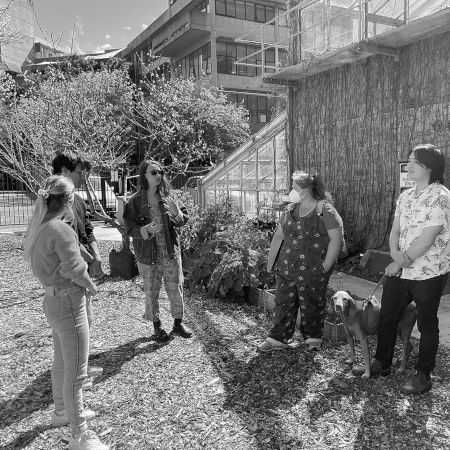Research /
Middle-out Workshops
Creating a coalition of ideas to facilitate collaborative decision-making
Middle-out workshops draw on a diverse range of actors to collaboratively work together in the city-making process, which can be used for designing, developing and deploying media architecture interventions. This approach incorporates the objectives, expertise and knowledge of top-down and bottom-up actors to meet in the middle with the purpose to move outward and forward.1 The mutual advantage of meeting in the middle is common to all partnerships and collaborations. Making compromises to consider the interests, wants and aspirations of different human and non-human actors can create a coalition of ideas to facilitate decision-making for collective action.
Middle-out workshops build on existing co-design and participatory design workshop models by including involved actors in every stage of the process.2 This includes the planning and design of workshop locations and activities, data collection methods and the analysis of the results. Typically, co-design and participatory design workshops are facilitated in controlled environments, such as design studios and laboratories, whereas middle-out workshops can also be run in urban environments and locations that connect participants directly to the city-making activity.
There are three distinct roles that form part of a middle-out workshop: (1) top-down actors, for example, people working in government agencies that create policy and regulatory requirements or people from industry that drive innovation and development in city infrastructure and technology platforms; (2) bottom-up actors, for example, representatives from community groups, First Nations people, culturally and linguistically diverse communities and local neighbourhoods; and (3) mediator(s) who acts as a facilitator. The mediator’s role is important for communicating with all actors and integrating their objectives into various workshop stages. This suggests that a successful middle-out workshop relies on an independent entity that does not have a direct interest in the workshop outcomes.
Middle-out workshops can be incorporated at any stage of the media architecture development process. In the research phase, they can be used to identify specific needs, circumstances and situations of urban dwellers. For media architecture projects, this includes developing a deep understanding of peoples’ connection to place, infrastructure and technology. During the design and prototype phases, middle-out workshops can generate ideas and rapidly iterate concepts, for example, designing and testing a smart city bench or interactive media installation. During the deployment phase, middle-out workshops can continue to include involved actors in post-deployment data analysis and the decision-making process.
Method Steps
-
Choose a media architecture project to address during the middle-out workshop. Create a document to capture the workshop objectives and ideas.
-
Identify and recruit a diverse range of actors who will come together as a working coalition of participants. It is important to understand the local context and select participants as representatives from both the top-down and bottom-up.
-
Outline the workshop objectives in relation to the topic. In collaboration with the coalition of participants, collectively outline the workshop objectives, for example:
-
What are the needs, wants and aspirations of each representative?
-
What do you expect to learn from the workshop? E.g. the key problems with current city-making initiatives.
-
What type of workshop activities will be used? E.g. physical activities, digital platforms, hybrid interventions.
-
What type of data will be collected during the workshop? E.g. talking about current experiences, outlining ideal experiences, generating new ideas.
-
-
Prepare workshop materials. Create a run sheet that outlines the structure and specific timeframes for activities. Use a combination of physical and digital interactions, for example, printed images, Post-it notes and butchers paper that participants can use to note down ideas or sketch concepts. Digital interactions could include online platforms that allow multiple people to interact, share ideas and generate concepts.
-
Run the workshop. Be sure to clearly outline the purpose and intended outcomes of the workshop. Explain the purpose of the activities and the use of associated materials and tools. Allow participants to explore their creative licence through storytelling, idea sharing and creating solutions.
-
Analyse the collected data using the Social Impact Assessment method. Involve the coalition of participants in this process. This could be facilitated as an additional session which would be run face-to-face or online.
